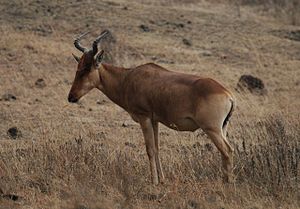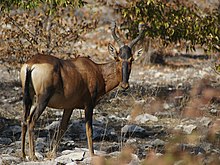Actual hartebeest
| Actual hartebeest | ||||||||||||
|---|---|---|---|---|---|---|---|---|---|---|---|---|

Kongoni hartebeest ( Alcelaphus cokii ) in the Ngorongoro crater |
||||||||||||
| Systematics | ||||||||||||
|
||||||||||||
| Scientific name | ||||||||||||
| Alcelaphus | ||||||||||||
| de Blainville , 1816 |
The authentics Kuhantilopen ( Alcelaphus ) are a kind of African antelopes from the tribe of Kuhantilopen (Alcelphini). The name Hartebeest , which is sometimes used in German, comes from Afrikaans .
features
With a head-torso length of 160 to 250 cm, a shoulder height of 108 to 150 cm and a weight of almost 120 to 185 kg, these antelopes are relatively large. The fur is light gray to reddish brown depending on the species. The black markings in the middle of the long face and legs as well as a distinctly light yellow or off-white mirror are striking . Just as clear and unmistakable is the shape of the horns, which grow from a common trunk and then bend outwards and upwards in the shape of a lyre. They are 70 cm long and are worn by both sexes, making them difficult to tell apart. The particularly high withers is also striking .
distribution

The red hartebeest were once widespread across the dry savannahs of Africa, from the Mediterranean coast to the Cape. Representatives are said to have also appeared in Palestine, but evidence of this is scarce. In southern East Africa the genus is represented by the Lichtenstein antelope . Today the red hartebeest are extinct in large parts of their former range.
Way of life
The red hartebeest are diurnal, herding antelopes. Like many other antelopes, the herds are segregated by sex. Females and young animals gather in groups of an average of 300 animals; these herds can also grow significantly larger, especially in Serengeti National Park , which has a total of 18,000 hartebeest. Young males often form bachelor groups, which are mostly small, in individual cases up to 35 individuals. At around four years of age, the males become territorial loners. They defend their own district against members of their sexes and lay claim to all females living in it. At the age of eight the males are too weak for these fights and lose their territories; they then wander around alone trying to avoid other males. The lifespan can be twenty years; however, few live to be older than ten years. Actual hartebeest are typical herbivores, but they also occasionally eat herbs and leaves from bushes. You drink regularly if possible, but you can do without water for a long time. On the run, they reach almost 80 km / h.
species
|
Internal systematics of the red hartebeest according to Flagstad et al. 2001
|
- North African hartebeest ( Alcelaphus buselaphus ( Pallas , 1766)); this species became extinct in the 1920s due to intensive hunting; it was common north of the Sahara from Morocco to Egypt
- Southern hartebeest or Kaama hartebeest ( Alcelaphus caama ( É. Geoffroy Saint-Hilaire , 1803)); in southern Africa
- Kongoni hartebeest or Cokes hartebeest ( Alcelaphus cokii Günther , 1884); the Kongoni lives in the savannas of Kenya and Tanzania and is by far the most common species
- Lelwel hartebeest ( Alcelaphus lelwel ( Heuglin , 1877)); in Chad, Congo and Uganda
- Lichtenstein antelope ( Alcelaphus lichtensteinii ( Peters , 1852))
- West African hartebeest ( Alcelaphus major ( Blyth , 1869)); in the savannahs of West Africa
- Somalia hartebeest ( Alcelaphus swaynei ( Sclater , 1892)); also threatened; Once at home in Somalia, today only isolated populations in the Ethiopian-Somali border area
- Torah hartebeest ( Alcelaphus tora Gray , 1873); the Torah is widespread in Ethiopia and Eritrea and is classified as endangered by the IUCN .
The Lichtenstein antelope was partially classified in its own genus Sigmoceros, but according to genetic analyzes it is very closely related to the southern hartebeest. The southern hartebeest, which is characterized by a striking red-brown fur and characteristic black fur markings on the face and legs, was almost extinct, but was able to survive in some national parks and is now becoming more common again.
As a rule, the forms recognized today were introduced as separate species in the 19th century. In 1929 AE Ruxton and Ernst Schwarz pushed all representatives of northern, eastern and western Africa to subspecies level within the species Alcelaphus buselaphus . In addition, they recognized the South African forms Alcelaphus lichtensteini and Alcelaphus caama as independent. Thus, they restricted the red hartebeest to three species. Later, the South African forms were incorporated into Alcelaphus buselaphus , which resulted in the species consisting of up to eight subspecies in the course of the 20th century. Molecular genetic studies in the transition to the 21st century then identified three distinct lines within the red hartebeest: a western with the West African hartebeest, an eastern with the Congonian, Lelwel, Somalia and Torah hartebeest and a southern one with the Lichtenstein and the southern hartebeest. The western and eastern lines were genetically closer, while the southern one acted as a sister group . Within the eastern group, the Torah and Somalia hartebeest each formed a monophyletic group, but there was a larger mixed group between the Somalia hartebeest and the other two eastern representatives. Subordinate individual overlaps also occurred between the western and eastern lines. Peter Grubb took the genetic findings in 2005 as an opportunity to recognize the two southern forms as independent again, so that, in his opinion, the genus again comprised three species. During a revision of the hornbeams in 2011, Colin P. Groves and Grubb also relocated the western and eastern forms to species status, also with reference to the molecular genetic data. Eight recent species are now recognized within the real hartebeest, of which the North African hartebeest has recently become extinct.
Danger
Drought and disease can quickly shrink populations. Red hartebeest populations decrease particularly sharply when there is competition from cattle herds. Hunting is also a threat in some places.
literature
- Jean Dorst and Pierre Dandelot: Mammals of Africa , Paul Parey Verlag, 1970. ISBN 3-490-01018-3
- Colin P. Groves and David M. Leslie Jr .: Family Bovidae (Hollow-horned Ruminants). In: Don E. Wilson, Russell A. Mittermeier (eds.): Handbook of the Mammals of the World. Volume 2: Hooved Mammals. Lynx Edicions, Barcelona 2011, ISBN 978-84-96553-77-4 , pp. 444-779
- L. Morris Gosling and Isabella Capellini: Genus Alcelaphus Hartebeest. In: Jonathan Kingdon, David Happold, Michael Hoffmann, Thomas Butynski, Meredith Happold and Jan Kalina (eds.): Mammals of Africa Volume VI. Pigs, Hippopotamuses, Chevrotain, Giraffes, Deer and Bovids. Bloomsbury, London, 2013, pp. 510-526
- Chris Stuart and Tilde Stuart: Field Guide to the Larger Mammals of Africa . Struik, 2000, ISBN 1-86872-534-0
- Don E. Wilson, DeeAnn M. Reeder (Eds.): Mammal Species of the World . 3rd edition. The Johns Hopkins University Press, Baltimore 2005, ISBN 0-8018-8221-4 .
Individual evidence
- ↑ a b c Colin P. Groves and David M. Leslie Jr .: Family Bovidae (Hollow-horned Ruminants). In: Don E. Wilson, Russell A. Mittermeier (eds.): Handbook of the Mammals of the World. Volume 2: Hooved Mammals. Lynx Edicions, Barcelona 2011, ISBN 978-84-96553-77-4 , pp. 694-698
- ↑ a b L. Morris Gosling and Isabella Capellini: Genus Alcelaphus Hartebeest. In: Jonathan Kingdon, David Happold, Michael Hoffmann, Thomas Butynski, Meredith Happold and Jan Kalina (eds.): Mammals of Africa Volume VI. Pigs, Hippopotamuses, Chevrotain, Giraffes, Deer and Bovids. Bloomsbury, London, 2013, pp. 510-526
- ↑ a b c Øystein Flagstad, Per Ole Syvertsen, Nils Chr. Stenseth and Kjetill S. Jascobsen: Environmental change and rates of evolution: the phylogeographic pattern within the hartebeest complex as related to climatic variation. Proceedings of the Royal Society of London B 268, 2001, pp. 667-677
- ^ AE Ruxton and Ernst Schwarz: On hybrid hartebeests and on the distribution of the Alcelaphus buselaphus group. Proceedings of the Zoological Society of London 99 (3), 1929, pp. 567-583
- ↑ Peter Arctander, Carsten Johansen and Marie-Agnès Coutellec-Vreto: Phylogeography of Three Closely Related African Bovids (Tribe Alcelaphini). Molecular Biology and Evolution 16 (12), 1999, pp. 1724-1739
- ↑ Don E. Wilson and DeeAnn M. Reeder: Mammal Species of the World. A taxonomic and geographic Reference. Johns Hopkins University Press, 2005 ( [1] )
- ↑ Colin P. Groves and Peter Grubb: Ungulate Taxonomy. Johns Hopkins University Press, 2011, pp. 1-317 (pp. 108-280)
Web links
- Alcelaphus buselaphus in the endangered Red List species the IUCN 2006. Posted by: Antelope Specialist Group, 1996. Retrieved on 11 May, 2006.
- Britta Meyer: Wildlife of special interest (PDF file, 87 kB; English)

